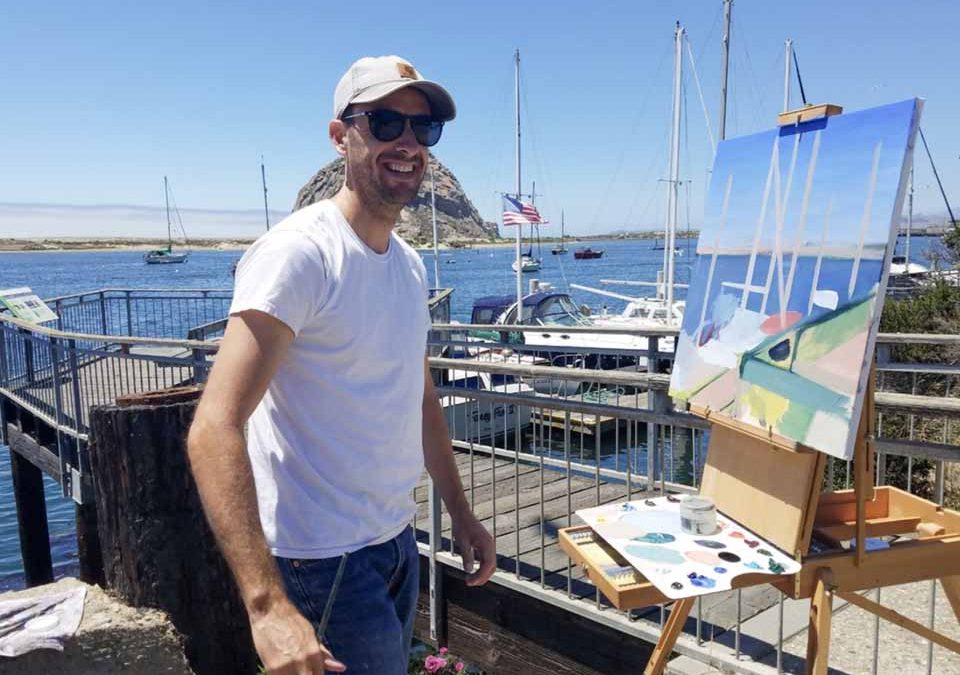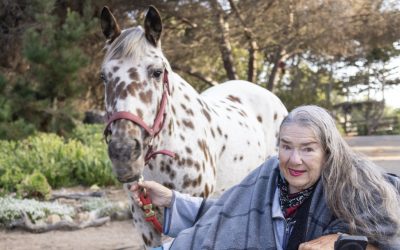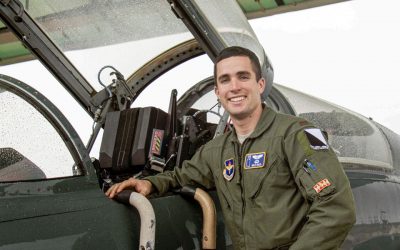If life experience is the best teacher, then San Luis Obispo artist Tony Girolo has a Ph.D. to accompany his Masters in Fine Arts from the Pennsylvania Academy of Fine Arts in Philadelphia, America’s oldest art school. A 1999 graduate of San Luis Obispo High School, Tony has traveled the country and the world to develop his artistic skills and vision. A selection of his paintings, which he titled “Lost and Found,” was featured in “Hometown,” a recent exhibition at the San Luis Obispo Museum of Art.
Tony was born in San Luis Obispo in 1980. His father, Jack, now retired, taught mathematics at Cal Poly, and his mother, Jeanne, is a writer who dedicated her time to raising Tony and his older sister, Claire. When Tony was four and five, Jack took a sabbatical in Florence, Italy, where Tony attended an international school. “I actually have a lot of memories from that trip. I remember seeing Caravaggios, the statue of David, all the plazas with their sculptures.”
Tony’s parents divorced when he was seven. He split time between two households until he was eighteen. Jeanne married Cal Poly physics professor, Ken Hoffman, who made breakthroughs in reversals in the earth’s magnetic field, which led to grants and international travel. “I spent a summer in London when I was thirteen. I skateboarded all over the city, but I wasn’t that aware of the art at that age, even though I had been recognized for my artistic ability in elementary school, especially by Nancy Howland at Bishop’s Peak.”
When he was a junior at SLOHS, Tony spent a semester in Geneva, Switzerland. He attended an international school, “my most formative experience as a young person. All the kids who were affiliated with the United Nations went there, over a hundred different nationalities. We had so much freedom. We drank beer at a pub at lunch, but the school created a real interest in academics in a different way than we experience here. The emphasis wasn’t on grades but on learning and on finding yourself. I really thrived there.”
Tony was born in San Luis Obispo in 1980. His father, Jack, now retired, taught mathematics at Cal Poly, and his mother, Jeanne, is a writer who dedicated her time to raising Tony and his older sister, Claire. When Tony was four and five, Jack took a sabbatical in Florence, Italy, where Tony attended an international school. “I actually have a lot of memories from that trip. I remember seeing Caravaggios, the statue of David, all the plazas with their sculptures.”
Tony’s parents divorced when he was seven. He split time between two households until he was eighteen. Jeanne married Cal Poly physics professor, Ken Hoffman, who made breakthroughs in reversals in the earth’s magnetic field, which led to grants and international travel. “I spent a summer in London when I was thirteen. I skateboarded all over the city, but I wasn’t that aware of the art at that age, even though I had been recognized for my artistic ability in elementary school, especially by Nancy Howland at Bishop’s Peak.”
When he was a junior at SLOHS, Tony spent a semester in Geneva, Switzerland. He attended an international school, “my most formative experience as a young person. All the kids who were affiliated with the United Nations went there, over a hundred different nationalities. We had so much freedom. We drank beer at a pub at lunch, but the school created a real interest in academics in a different way than we experience here. The emphasis wasn’t on grades but on learning and on finding yourself. I really thrived there.”
Three influential art teachers from England, Iran and Chicago combined to spark Tony’s interest in painting. “I learned to paint using oils. When you first discover oil it’s so rich. Before that, I had used mostly craft paint, cheap acrylics. Those six months were like the dream of youth.”
During his senior year in high school, Tony took art skills classes and started painting more on his own. “I had to learn how to buy canvasses, use paint thinner, to become familiar with the materials artists use. I started taking life drawing lessons every Saturday with Poly professor Robert Dencham. I was really focused on my artistic skills.”
After graduating Tony attended San Francisco State for a year. “Looking back, I was still really young and naïve. I wasn’t quite ready for the city. I focused on getting good grades so I could go somewhere else. I was accepted at St. Mary’s College in Maryland, a smaller school with an emphasis on the humanities, which ended up being a wonderful experience. I developed personally and had a great group of artist and musician friends, people I could relate to.”
During his senior year in high school, Tony took art skills classes and started painting more on his own. “I had to learn how to buy canvasses, use paint thinner, to become familiar with the materials artists use. I started taking life drawing lessons every Saturday with Poly professor Robert Dencham. I was really focused on my artistic skills.”
After graduating Tony attended San Francisco State for a year. “Looking back, I was still really young and naïve. I wasn’t quite ready for the city. I focused on getting good grades so I could go somewhere else. I was accepted at St. Mary’s College in Maryland, a smaller school with an emphasis on the humanities, which ended up being a wonderful experience. I developed personally and had a great group of artist and musician friends, people I could relate to.”
At St. Mary’s Tony met his art mentor, Jeff Carr, an artist from San Diego, who had studied with famous American artists like William Bailey and Leland Bell. Through Carr, Tony was accepted to a summer program in Italy in 2003, run by artists from the Chicago Art Institute and Yale University. “It was called the International School of Drawing, Painting and Sculpture, in Umbria. I stayed in a little hill town and went out to paint the Italian countryside. It was exposure to the real art world. The critiques were really difficult, like kick you to the curb and see if you get up.” One of Tony’s paintings was chosen as the cover for an exhibition at the end of the program.
Back in San Luis Obispo with a Bachelor in Fine Arts degree, Tony worked at The Palm Theater and applied and was accepted to the Pennsylvania Academy of Fine Art. “I was following a natural path, doing what I loved to do. I was still struggling personally, still maturing, but art was a haven for me and the Academy was a great experience. It’s kind of an Old Masters school so I got a great foundation in technique and materials.”
In his second year, Tony felt that the pressure for high achievement he had put on himself became distorted. “I put up an amazing wall of paintings, but I hadn’t learned self-care yet, how to balance my life. I ended with an impressive show, I sold some paintings, but I kind of collapsed afterward. I’d been able to focus on my craft, but I ended up in a position where I couldn’t really get a job, didn’t know how I was going to apply my skills. There was a schism between high academic achievement and moving ahead with my personal life.”
Back in San Luis Obispo with a Bachelor in Fine Arts degree, Tony worked at The Palm Theater and applied and was accepted to the Pennsylvania Academy of Fine Art. “I was following a natural path, doing what I loved to do. I was still struggling personally, still maturing, but art was a haven for me and the Academy was a great experience. It’s kind of an Old Masters school so I got a great foundation in technique and materials.”
In his second year, Tony felt that the pressure for high achievement he had put on himself became distorted. “I put up an amazing wall of paintings, but I hadn’t learned self-care yet, how to balance my life. I ended with an impressive show, I sold some paintings, but I kind of collapsed afterward. I’d been able to focus on my craft, but I ended up in a position where I couldn’t really get a job, didn’t know how I was going to apply my skills. There was a schism between high academic achievement and moving ahead with my personal life.”
After a year in Portland, Tony returned to Philadelphia to reintegrate with his friends there, spent a year teaching art at Radnor College and then returned to San Luis Obispo. He was in his late twenties, “trying to navigate the financial thing. I wanted to paint but I had to work. I worked in restaurants, but then started house painting for companies like Browder. I was learning about a different part of the world, but I felt like a tourist and my co-workers were permanent residents.”
Life started to change when Tony was hired to teach at Hancock and Cuesta simultaneously in 2012, which he did for three years. The uncertainty of being part-time led him to taking classes at America’s Job Center and through that experience he was hired by County Social Services to be an employment resource specialist, assisting clients who receive benefits from the county. The job provided financial stability and allowed him to return to painting.
“I was living at the Establishment, some of the lowest rent imaginable in this area. I was able to rent a studio at The Bunker, an art collective run by Missy Reitner. I spent two-and-a-half years there, my most prolific as an adult. I really started finding my voice as an artist, separate from what I did at school. I could leave the academic world behind. I didn’t have to encode everything in a language that referenced the past.”
Life started to change when Tony was hired to teach at Hancock and Cuesta simultaneously in 2012, which he did for three years. The uncertainty of being part-time led him to taking classes at America’s Job Center and through that experience he was hired by County Social Services to be an employment resource specialist, assisting clients who receive benefits from the county. The job provided financial stability and allowed him to return to painting.
“I was living at the Establishment, some of the lowest rent imaginable in this area. I was able to rent a studio at The Bunker, an art collective run by Missy Reitner. I spent two-and-a-half years there, my most prolific as an adult. I really started finding my voice as an artist, separate from what I did at school. I could leave the academic world behind. I didn’t have to encode everything in a language that referenced the past.”
Back in a community of artists, Tony started getting shows and connecting with other artists whose work he identified with. “I’ve done really cool group shows at local salons, and I had a three-week residency and show in San Juan, Puerto Rico, in 2017. My recent show at SLOMA was my first museum show.”
Tony describes his current work as both realistic and abstract, influenced by his travels and the many urban experiences he’s had. “There’s an existential quality to the work, the value of urban aesthetics. I find a lot of meaning in art and culture from cities, and the proximity to the art scene in Los Angeles helps keep me connected. There’s a modernist impulse in the work I’m doing, wanting to create a sense of urgency and improvisation, as in music, street art, skateboarding, which I’ve done my whole life.”
When I asked Tony about his future as an artist, he said, “It’s been really hard. I feel like I’ve sacrificed a lot. I’ve put so much work into it. When I think of the last twenty years, if I’d done something conventional I’d be a millionaire. But I’ve become really strong through it, and I’m still creating a synergy between work, art and personal life. I’m open to whatever happens.”
Tony has applied for the Rome Prize, a fellowship through the American Academy in Rome, and a Pollock Krasner grant, established at the bequest of Lee Krasner, an American abstract expressionist and the widow of Jackson Pollock. For more information about Tony and his work, go to www.tonygiroloart.com.
Tony describes his current work as both realistic and abstract, influenced by his travels and the many urban experiences he’s had. “There’s an existential quality to the work, the value of urban aesthetics. I find a lot of meaning in art and culture from cities, and the proximity to the art scene in Los Angeles helps keep me connected. There’s a modernist impulse in the work I’m doing, wanting to create a sense of urgency and improvisation, as in music, street art, skateboarding, which I’ve done my whole life.”
When I asked Tony about his future as an artist, he said, “It’s been really hard. I feel like I’ve sacrificed a lot. I’ve put so much work into it. When I think of the last twenty years, if I’d done something conventional I’d be a millionaire. But I’ve become really strong through it, and I’m still creating a synergy between work, art and personal life. I’m open to whatever happens.”
Tony has applied for the Rome Prize, a fellowship through the American Academy in Rome, and a Pollock Krasner grant, established at the bequest of Lee Krasner, an American abstract expressionist and the widow of Jackson Pollock. For more information about Tony and his work, go to www.tonygiroloart.com.





